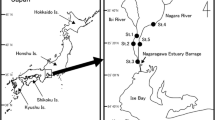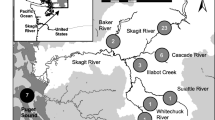Abstract
The migratory life histories of 37 Atlantic tarpon (Megalops atlanticus) caught from offshore waters of French Guiana were quantified using otolith Sr:Ca and Ba:Ca ratios. In general Sr:Ca ratio was more informative marker for inferring movements along salinity gradients, but Ba:Ca ratio was used to infer movements to estuarine mixing zones with high Ba availability. All sampled individuals had made use of marine and brackish water but only 8 % had experienced fresh water and 24 % hypersaline water. The newly-hatched post-metamorphic larvae recruited to brackish (49 %), sea (43 %), fresh (5 %) and hypersaline (3 %) water nursery areas. Following the settlement to nursery areas Atlantic tarpon likely displayed facultative habitat selection and complex set of inter-habitat shifting among waters of various salinity. The combined use of both markers allowed us to conclude that brackish (estuarine) areas are likely the main habitat for Atlantic tarpon in French Guiana, and fresh water use is surprisingly rare. As no general migratory life-history emerged, and because Atlantic tarpon seemed rather facultative in its habitat use, it should be regarded as ‘euryhaline marine migrantʼ.



Similar content being viewed by others
References
Adams A, Guindon K, Horodysky A, MacDonald T, McBride R, Shenker J, Ward R (2012) Megalops atlanticus. The IUCN Red List Threatened Species 2012: e.T191823 A2006676
Adams AJ, Horodysky AZ, McBride RS, Guindon K, Shenker J, MacDonald TC, Harwell HD, Ward R, Carpenter K (2014) Global conservation status and research needs for tarpons (Megalopidae), ladyfishes (Elopidae) and bonefishes (Albulidae). Fish Fish 15:280–311
Andrews AH, Burton EJ, Coale KH, Cailliet GM, Crabtree RE (2001) Radiometric age validation of Atlantic tarpon, Megalops atlanticus. Fish B-NOAA 99:389–398
Brown RJ, Severin KP (2008) A preliminary otolith microchemical examination of the diadromous migrations of Atlantic tarpon Megalops atlanticus. In: Ault JS (ed) Biology and Management of the World Tarpon and Bonefish Fisheries, pp 259–274
Brown RJ, Severin KP (2009) Otolith chemistry analyses indicate that water Sr:Ca is the primary factor influencing otolith Sr:Ca for freshwater and diadromous fish but not for marine fish. Can J Fish Aquat Sci 66:1790–1808
Campana SE (1999) Chemistry and composition of fish otoliths: pathways, mechanisms, and applications. Mar Ecol-Prog Ser 188:263–297
Campbell LA, Bottom DL, Volk EC, Fleming IA (2015) Correspondence between Scale Morphometrics and Scale and Otolith Chemistry for Interpreting Juvenile Salmon Life Histories. T Am Fish Soc 144:55–67
Chen HL, Shen KN, Chang CW, Iizuka Y, Tzeng WN (2008) Effects of water temperature, salinity and feeding regimes on metamorphosis, growth and otolith Sr:Ca ratios of Megalops cyprinoides leptocephali. Aquat Biol 3:41–50
Coffey M, Dehairs F, Collette O, Luther G, Church T, Jickells T (1997) The behaviour of dissolved barium in estuaries. Estuar Coast Shelf S 45:113–121
Colbert D, McManus J (2005) Importance of seasonal variability and coastal processes on estuarine manganese and barium cycling in a Pacific Northwest estuary. Cont Shelf Res 25:1395–1414
Crabtree RE, Cyr EC, Bishop RE, Falkenstein LM, Dean JM (1992) Age and growth of tarpon, Megalops atlanticus, larvae in the eastern Gulf of Mexico, with notes on relative abundance and probable spawning areas. Environ Biol Fish 35:361–370
Crabtree RE, Cyr EC, Dean JM (1995) Age and growth of tarpon, Megalops atlanticus, from south Florida waters. Fish B-NOAA 93:619–628
Crook DA, Macdonald JI, O’Connor JP, Barry B (2006) Use of otolith chemistry to examine patterns of diadromy in the threatened Australian grayling Prototroctes maraena. J Fish Biol 69:1330–1344
de Menezes MF, Paiva MP (1966) Notes on the biology of tarpon, Tarpon atlanticus (Cuvier and Valenciennes), from coastal waters of Ceara State, Brazil. Arquivos da Estação de Biologia Marinha da Universidade Federal do Ceará 6:83–98
Diouf K, Panfili J, Labonne M, Aliaume C, Tomás J, Do Chi T (2006) Effects of salinity on strontium:calcium ratios in the otoliths of the West African black-chinned tilapia Sarotherodon melanotheron in a hypersaline estuary. Environ Biol Fish 77:9–20
Elliott M, Whitfield AK, Potter IC, Blaber SJM, Cyrus DP, Nordlie FG, Harrison TD (2007) The guild approach to categorizing estuarine fish assemblages: a global review. Fish Fish 8:241–268
Elsdon TS, Wells BK, Campana SE, Gillanders BM, Jones CM, Limburg KE, Secor DH, Thorrold SR, Walther BD (2008) Otolith chemistry to describe movements and life-history measurements of fishes: hypotheses, assumptions, limitations, and inferences using five methods. Oceanography and Marine Biology: An Annual Review 46:297–330
Forey PL, Littlewood DTJ, Ritchie P, Meyer A (1996) Interrelationships of elopomorph fishes. In: Stiassny MLJ, Parenti LR, Johnson GD (eds) Interrelationships of fishes. Academic Press, San Diego, pp. 175–191
Gillanders BM (2001) Trace metals in four structures of fish and their use for estimates of stock structure. Fish B-NOAA 99:410–419
Gillanders BM, Munro AR (2012) Hypersaline waters pose new challenges for reconstructing environmental histories of fish based on otolith chemistry. Limnol Oceanogr 57:1136–1148
Jones PW, Martin FD, Hardy JD (1977) Development of fishes of the Mid-Atlantic Bight: an atlas of egg, larval and juvenile stages. Vol. 1: Acipenseridae through Ictaluridae. U.S. Fish Wildl. Serv. Biol. Serv. Program FWS/OBS-78/12. 366 pp
Mateos-Molina D, Schärer-Umpierre M, Nemeth M, Ruiz H, Ruiz-Valentín I, Vargas-Santiago, J. (2013) Ecology and Distribution of Tarpons (Megalops atlanticus) at the Boquerón Wildlife Refuge, Puerto Rico. Proceedings of the 65th Gulf and Caribbean Fisheries Institute, pp 262–265
McDowall RM (1988) Diadromy in fishes: Migrations between freshwater and marine environments. Timber Press, Portland, 250 pp
Miller JA (2007) Scales of variation in otolith elemental chemistry of juvenile staghorn sculpin (Leptocottus armatus) in three Pacific northwest estuaries. Mar Biol 151:483–494
Morales-Nin B, Geffen AJ, Pérez-Mayol S, Palmer M, González-Quirós R, Grau A (2012) Seasonal and ontogenic migrations of meagre (Argyrosomus regius) determined by otolith geochemical signatures. Fish Res 127–128:154–165
Myers GS (1949) Usage of anadromous, catadromous and allied terms for migratory fishes. Copeia 1949:89–97
Panfili J, Darnaude AM, Vigliola L, Jacquart A, Labonne M, Gilles S (2015) Experimental evidence of complex relationships between the ambient salinity and the strontium signature of fish otoliths. J Exp Mar Biol Ecol 467:65–70
Payne Wynne ML, Wilson KA, Limburg KE (2015) Retrospective examination of habitat use by blueback herring (Alosa aestivalis) using otolith microchemical methods. Can J Fish Aquat Sci 72:1073–1086
Riede K. (2004) Global register of migratory species - from global to regional scales. Final Report of the R&D-Projekt 808 05 081. Federal Agency for Nature Conservation, Bonn, Germany, 329 p
Rohtla M, Vetemaa M, Taal I, Svirgsden R, Urtson K, Saks L, Verliin A, Kesler M, Saat T (2014) Life history of anadromous burbot (Lota lota, Linneaus) in the brackish Baltic Sea inferred from otolith microchemistry. Ecol Freshw Fish 23:141–148
Rohtla M, Svirgsden R, Taal I, Saks L, Eschbaum R, Vetemaa M (2015) Life-history characteristics of ide Leuciscus idus in the eastern Baltic Sea. Fisheries Manag. Ecol 22:239–248
Secor DH, Rooker JR (2000) Is otolith strontium a useful scalar of life cycles in estuarine fishes? Fish Res 46:359–371
Seeley M, Miller N, Walther B (2015) High resolution profiles of elements in Atlantic tarpon (Megalops atlanticus) scales obtained via cross-sectioning and laser ablation ICP-MS: a literature survey and novel approach for scale analyses. Environ Biol Fish 98:2223–2238
Shen KN, Chang CW, Iizuka Y, Tzeng WN (2009) Facultative habitat selection in Pacific tarpon Megalops cyprinoides as revealed by otolith Sr:ca ratios. Mar Ecol-Prog. Ser 387:255–263
Simier M, Blanc L, Aliaume C, Diouf PS, Albaret JJ (2004) Spatial and temporal structure of fish assemblages in an “inverse estuary”, the Sine Saloum system (Senegal). Est Coast Shelf Sci 59:69–86
Stecher HA, Kogut MB (1999) Rapid barium removal in the Delaware estuary. Geochim Cosmochim Ac 63:1003–1012
Walther BD, Limburg KE (2012) The use of otolith chemistry to characterize diadromous migrations. J Fish Biol 81:796–825
Whitfield A (1999) Ichthyofaunal assemblages in estuaries: A South African case study. Rev Fish Biol and Fisher 9:151–186
Woodcock SH, Walther BD (2014) Trace elements and stable isotopes in Atlantic tarpon scales reveal movements across estuarine gradients. Fish Res 153:9–17
Zale AV, Merrifield SG (1989) Species Profiles: Life Histories and Environmental Requirements of Coastal Fishes and Invertebrates (South Florida) – Ladyfish and Tarpon. U.S. Fish and Wildlife Servive Biological Report 82(11.104). 17 pp
Acknowledgments
M.R. received travelling funds from the European Social Fund financed by European Union and universities, which in Estonia is managed by Doctoral School of Earth Sciences and Ecology. We thank A. Ungerer (Oregon State University) for his help with the otolith analyses. We also thank two anonymous reviewers for their comments.
Author information
Authors and Affiliations
Corresponding author
Rights and permissions
About this article
Cite this article
Rohtla, M., Vetemaa, M. Otolith chemistry chimes in: migratory environmental histories of Atlantic tarpon (Megalops atlanticus) caught from offshore waters of French Guiana. Environ Biol Fish 99, 593–602 (2016). https://doi.org/10.1007/s10641-016-0501-1
Received:
Accepted:
Published:
Issue Date:
DOI: https://doi.org/10.1007/s10641-016-0501-1




